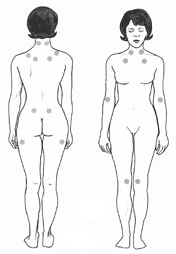By Dr. Dave Edenfield
Anyone who has ever suffered
through the debilitating pain of a lower back injury understands the importance
of maintaining a healthy back. The
problem is that automobile accidents and unexpected falls are not the only way
in which to injure your lower back. Sad
to say it but the biggest cause of back injury has to do with an occupational
hazard that is all too common: Sitting.
Many of us work in offices or
from home where our nine-to-five jobs require us to sit for eight or more hours
at a time. Especially if your business
consists of working at a desk for most of the day, this can cause a great deal
of strain on your lower back. The human body was never designed for extended
sitting. It was designed for bipedal
motion required to hunt and gather food and flee from predators. It was not created for being a couch
potato.
Worse still is the fact that
many people go straight home after sitting for eight hours only to resume the
position in front of a TV for another four hours. It’s a wonder most people can walk at all. The spine has a hard time dealing with the
unnatural position that being seated creates.
Other than the added pressure to your disks and strain to e muscles created
by forcibly bending your back when you sit, the electrical activity in your
muscles also slows substantially. What
this leads to is a reduction in the muscles ability to burn fat and process
blood sugar. Over time this will affect
your body’s ability to do simple things like walk and climb stairs.
Because of these factors,
sitting for long periods of time can lead to weight gain and bone loss, neither
of which is going to help your back.
According to a report by the Surgeon General, up to one percent of bone
mass can occur by sitting for as little as six hours per day.
Adults can benefit
from exercise as well. Studies show that spine loading exercise (e.g., rowing,
upper-body lifting) increases bone density by 2% to 3%; use of a weighted vest
combined with impact exercise increases hip BMD by 2% to 3% and also improves
lower body strength, balance, and power; controlled impact exercises such as
jumping increase hip BMD by 3%; and step aerobics and jumping increase spine
and hip BMD by 1% to 2%. In some cases, these benefits can accrue with as
little as 5 to 10 minutes of exercise, 5 days a week. That said, adults must
continue exercising if they want to maintain these benefits. Studies show that
adults lose 1% to 3% of bone mass within three to six months of ending an
exercise regimen. As Dr. Snow noted, “if adults don’t use it (bone mass), they
lose it.” http://www.ncbi.nlm.nih.gov/books/NBK44683/
These Boots Were Made
for Walking
When it
comes to exercise, you don’t have to enroll in a gm. Actually one of the best exercises for spine
health is walking. The spine is naturally
designed for walking. This is where it is at its best. Simply going for a walk
every day in the morning or after work can have tremendous benefits for your
back. Plus it can pay BIG dividends for
your heart and weight as well. This is
one of the reasons that dog owners have fewer back issues. They are forced to walk their pets several
times each day. As a result not only
does Fido get a chance to answer nature’s call, but his or her owner also gets
a chance to stretch their legs as well.
 Speaking of
stretching, another important factor in maintaining a healthy back is to
stretch every day. While some people are
into Yoga and Tai Chi, both of which are excellent stretching routines, simple
stretching of the calves, backs of the thighs and front of the legs can help to
keep the back strong and flexible.
Stretching also helps your muscles avoid the shock of stressful
activity. (This is the main reason that
athletes stretch before they engage in sports.)
Speaking of
stretching, another important factor in maintaining a healthy back is to
stretch every day. While some people are
into Yoga and Tai Chi, both of which are excellent stretching routines, simple
stretching of the calves, backs of the thighs and front of the legs can help to
keep the back strong and flexible.
Stretching also helps your muscles avoid the shock of stressful
activity. (This is the main reason that
athletes stretch before they engage in sports.)
While chiropractic care can
help you recover from back injuries, the best way to avoid going to the
doctor’s office is the make subtle changes in your lifestyle that will help you
keep your back happy and healthy. This
way when those around you succumb to the stresses of modern life, you can be
the last man (or woman) standing.
Dr. Dave Edenfield and Dr. Steven Warfield are part of the team of
doctors and therapists at http://chiropractic-jacksonville-fl.com and http://endyourpain.org who are dedicated to helping you and your
family lead healthier,
happier and pain-free lives.















